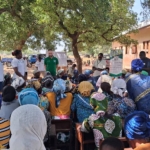
Tree Aid Ghana, an environmentally focused organisation, has begun implementing a major carbon restoration project in the North East Region aimed at restoring degraded landscapes and strengthening community resilience to climate change.
The initiative dubbed “Tiisi Tenga” (Land of Trees), which also covers parts of the Upper East Region, is expected to restore about 200,000 hectares of degraded lands across 20 communities, mostly along the White Volta River, with a target to sequester approximately 3.4 tonnes of carbon per hectare.
The main objective of the project is to guide farmers in the adoption of agroforestry systems to restore and recover degraded farmlands, using strategies that reconcile conservation with social benefits and build resilience of community to climate change and strengthen food security systems.
The Country Programmes Manager for Tree Aid Ghana, Robert Atawura, who disclosed this at separate community validation workshops, said the organisation was currently implementing the first phase of the project in four communities, Kurugu, Kparikpiri, Kpatusi and Gbeo in the West Mamprusi Municipality.
Under the agroforestry and land restoration system and activities, he said, tree species such as cassia, mahogany, teak, mango, cashew and shea were planted, adding the beneficiary communities had so far planted about 370,000 trees on communal and private lands, covering 1,000 hectares.
Mr Atawura explained that the communities were undertaking various interventions, including agroforestry, tree planting, protection and nurturing of seedlings to ensure high survival rates, targeting 3,200 hectares across the 20 communities.
“In the dry season, as part of protecting the planted trees, we are engaging the communities in tree irrigation, fire belt creation and the establishment of tree protection groups to regularly monitor the plantations and protect them from fire and livestock,” he said.
He stressed that chiefs, landowners and families had been involved from the beginning because the carbon project required long-term commitment to land use and tree protection for at least 40 years, estimating to sequester 3.5 metric tonnes of carbon dioxide over the period.
“The aim is to ensure that the carbon being sequestered benefits the communities. When communities begin to earn from restored lands, they will fully appreciate the need to protect the environment,” he added.
Mr Atawura said the validation workshop formed part of efforts to review the social biodiversity impact assessment conducted in the beneficiary communities and to confirm that identified issues and planned activities reflected community priorities.
He explained that a legal team had presented draft agreements to the communities for review to ensure that all parties were satisfied before signing, adding that this was crucial for long-term collaboration.
The project is expected to expand to additional communities in subsequent years after lessons from the first phase have been reviewed and incorporated into the implementation approach.
The Head of Department of Agriculture, West Mamprusi Municipality, Peter Claver Anyeember, commended the project for targeting communities adversely affected by the impacts of climate change.
He said that when the degraded lands and forests were restored, it would boost agricultural production and urged the farming communities to embrace the project and contribute to mitigating climate change impact and rainfall patterns and strengthen food security.
The Assemblyman for Kurugu Electoral Area, Alhassan Mohammed, lauded the project, saying apart from the fact that the communities would benefit from carbon sequester to improve income levels, it would help to address excessive heat, improve rainfall patterns and food production.
“We are ready to support the project to succeed because we know the benefits the project is bringing to our communities, thus, improved climate, soil fertility and increased crop yields, which will help to address the low crop yields caused by erratic rainfall in recent years”, he said.